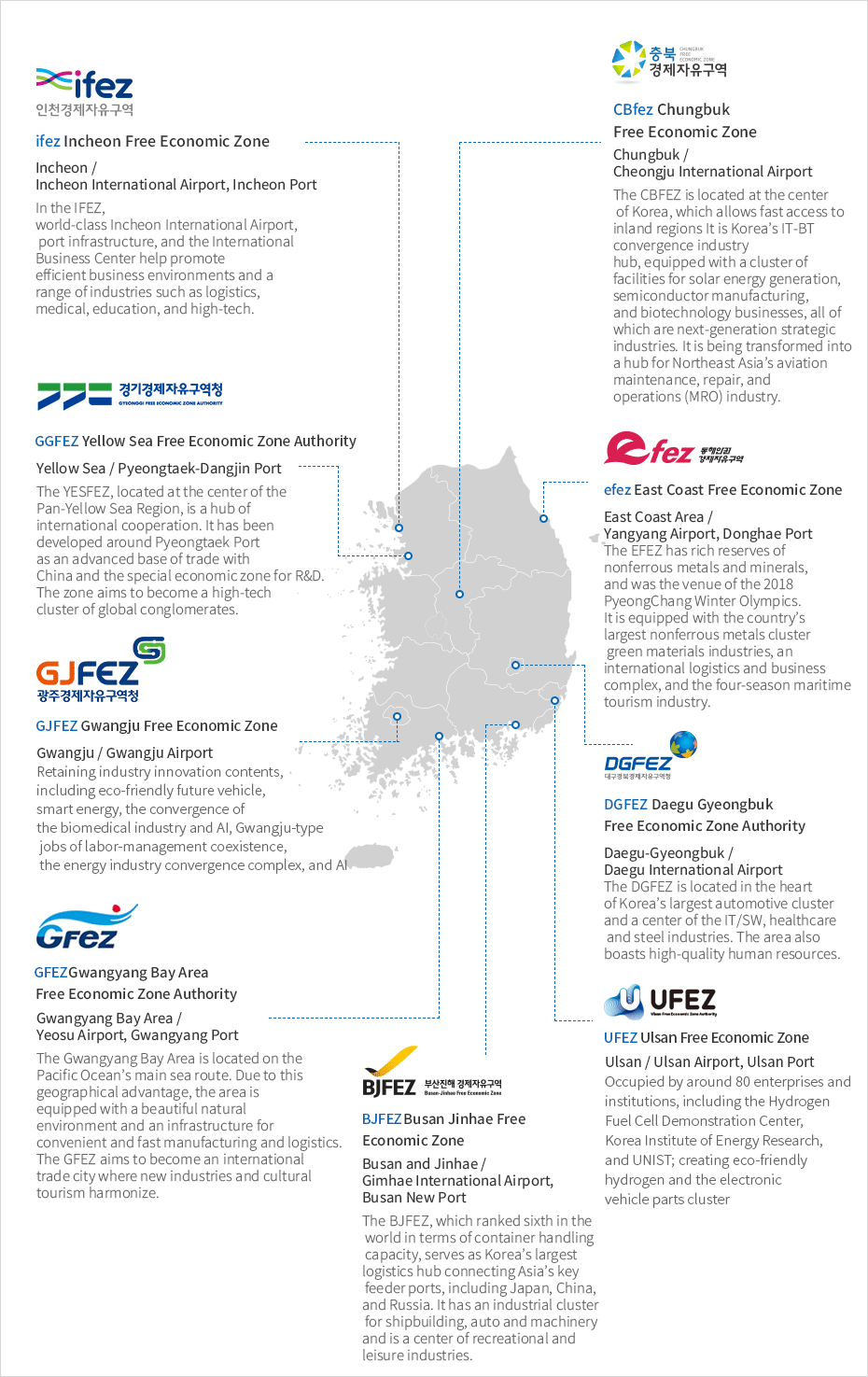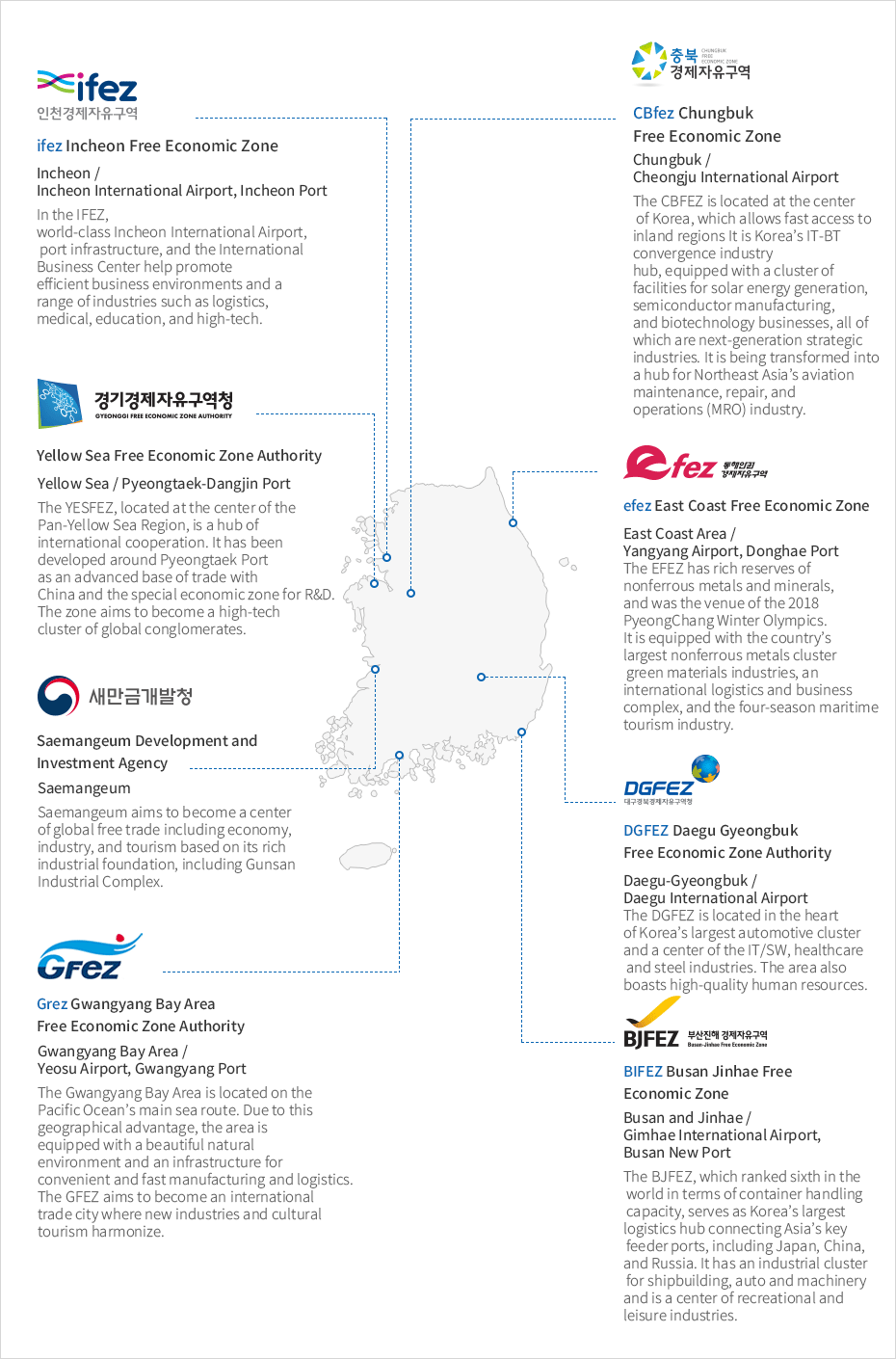- Home
- Incentives
- Location Support
- Free Economic Zones
Free Economic Zones
Requirements for occupancy
Designation of Free Economic Zones
| Category | Incheon | Busan·Jinhae | Gwangyang Bay Area | Daegu·Gyeongbuk | Gyeonggi |
|---|---|---|---|---|---|
| Location | Incheon (Yeonsu-gu, Jung-gu, Seo-gu) | Busan (Gangseo-gu), Gyeongnam (City of Changwon) | Jeonnam (Yeosu, Suncheon, Gwangyang), Gyeongnam (Hadong-gun) | Daegu, Gyeongbuk (Gyeongsan, Yeongcheon, Pohang) | Gyeonggi (Pyeongtaek, siheung) |
| Area (㎢) | 122.44 | 51.06 | 59.8 | 18.45 | 5.24 |
| Airport & Port | Incheon Int'l Airport, Port of Incheon | Gimhae Int'l Airport, Busan New Port | Gwangyang Port, Yeosu Airport | Daegu Int'l Airport | Pyeongtaek·Dangjin Port |
| Period | 2003-2022 | 2003-2023 | 2003-2022 | 2008-2022 | 2008-2020 |
| Business District | Songdo, Yeongjong, Cheongna | New Port, Myeongji, Jisa, Dudong, Ungdong | Gwangyang, Yulchon, Sindeok, Hwayang, Gyeongdo, Hadong | Daegu, Yeongcheon, Gyeongsan, Pohang | Pyeongtaek BIX, Hyeondeok |
| Eligible Business | International business, IT, BT, R&D, aviation, logistics, tourism, finance, leisure, high-tech industries | Busan New Port logistics hub, international business, high-tech parts and materials, R&D, vacation, recreation, leisure | Logistics, manufacturing, steel, machinery, assembling, metals, new renewable energy, tourism, leisure | High-tech transport, parts and materials, high-tech medical, IT convergence | Automobile parts, logistics, electronics, chemical, distribution, commerce, residence, tourism, medical, etc. |
| Category | Gangwon | Chungbuk | Gwangju | Ulsan |
|---|---|---|---|---|
| Location | Gangwon (Gangneung, Donghae) | Chungju | Gwangju (Gwangsan-gu, Nam-gu, Buk-gu) | Ulsan (Nam-gui, Buk-gu, Ulju-gun) |
| Area (㎢) | 4.44 | 4.96 | 4.371 | 4.7 |
| Airport & Port | Yangyang Int'l Airport, Port of Donghae) | Cheongju Int'l Airport | Gwangju Airport | Ulsan Airport, Port of Ulsan |
| Period | 2013-2024 | 2013-2020 | 2020-2025 | 2020-2030 |
| Business District | Bukpyeong, Mangsang, Okgye | Biomedical, bio-polis, aero-polis | Future vehicle, smart energy, AI convergence district | Hydrogen Industry Base District, Electrogen Auto Valley, R&D Business Valley |
| Eligible Business | High-tech materials, logistics, business, and other luxurious tourism industries such as industries, healthcare, tourism, marine tourism, nonmetallic industry, ultralight high-tech materials and parts industry, settlement environment such as residence, education, healthcare, and culture | IT, BT, high-tech sectors and research institutes, air transportation, logistics, aviation training institute, aircraft parts manufacturing, aviation education and research facility, medical R&D institute, advanced clinical trial center, research hospital | Future vehicle, Ai convergence, smart energy | Hydrogen industry, automotive parts, fuel cell |
Incentives
| Category | Tax | Tax Reduction or Exemption Period and Rates | Requirements for Tax Reductions or Exemptions | ||
|---|---|---|---|---|---|
| Foreign-Invested Company in Free Economic Zone | National tax | Tariff | 5 years from the date of import notification | Imported capital goods | |
| Local tax | Acquisition tax | Up to 15 years under ordinances: 100% |
Manufacturing: At least USD 10 million Tourism: At least USD 10 million Logistics: At least USD 5 million Medical institution: At least USD 5 million R&D: At least 1 million |
||
| Property tax | |||||
| Financial Support | Cash grants |
|
|||
| Infrastructure support |
Road, rail, airport, port, sewage, waste disposal, etc. (Requirements) 50% support from government expenditure; 100% if decided by the Free Economic Zone Committee |
||||
|
Foreign education, research institution support |
Preparation, initial operation, and construction expenses for foreign education and research institutions (Requirements) Meet evaluation elements, such as reputation and contribution to Korea’s development |
||||
| Rental fees |
|
||||
| Other Support | Relief from labor regulations |
|
|||
| Free foreign exchange transaction | Permission of direct current transaction of USD 10,000 or under | ||||
| Exclusion of application of the 「Seoul Metropolitan Area Reorganization Planning Act」 |
|
||||
Status of Free Economic Zones and Saemangeum


- Incheon Free Economic Zone
Incheon / Incheon International Airport, Incheon Port In the IFEZ, world-class Incheon International Airport, port infrastructure, and the International Business Center help promote efficient business environments and a range of industries such as logistics, medical, education, and high-tech.
-
Chungbuk Free Economic Zone
Chungbuk / Cheongju International Airport The CBFEZ is located at the center of Korea, which allows fast access to inland regions It is Korea’s IT-BT convergence industry hub, equipped with a cluster of facilities for solar energy generation, semiconductor manufacturing, and biotechnology businesses, all of which are next-generation strategic industries. It is being transformed into a hub for Northeast Asia’s aviation maintenance, repair, and operations (MRO) industry.
-
East Coast Free Economic Zone
East Coast Area / Yangyang Airport, Donghae Port The EFEZ has rich reserves of nonferrous metals and minerals, and was the venue of the 2018 PyeongChang Winter Olympics.It is equipped with the country’s largest nonferrous metals cluster, green materials industries, an international logistics and business complex, and the four-season maritime tourism industry.
-
Yellow Sea Free Economic Zone Authority
Yellow Sea / Pyeongtaek-Dangjin Port The YESFEZ, located at the center of the Pan-Yellow Sea Region, is a hub of international cooperation. It has been developed around Pyeongtaek Port as an advanced base of trade with China and the special economic zone for R&D.
-
Daegu Gyeongbuk Free Economic Zone Authority
Daegu-Gyeongbuk / Daegu International Airport The DGFEZ is located in the heart of Korea’s largest automotive cluster and a center of the IT/SW, healthcare, and steel industries. The area also boasts high-quality human resources.
-
Saemangeum Development and Investment Agency
Saemangeum Saemangeum aims to become a center of global free trade including economy, industry, and tourism based on its rich industrial foundation, including Gunsan Industrial Complex.
-
Gwangyang Bay Area Free Economic Zone Authority
Gwangyang Bay Area / Yeosu Airport, Gwangyang Port The Gwangyang Bay Area is located on the Pacific Ocean’s main sea route. Due to this geographical advantage, the area is equipped with a beautiful natural environment and an infrastructure for convenient and fast manufacturing and logistics.The GFEZ aims to become an international trade city where new industries and cultural tourism harmonize.
-
Busan Jinhae Free Economic Zone
Busan and Jinhae / Gimhae International Airport, Busan New Port The BJFEZ, which ranked sixth in the world in terms of container handling capacity, serves as Korea’s largest logistics hub connecting Asia’s key feeder ports, including Japan, China, and Russia. It has an industrial cluster for shipbuilding, auto and machinery and is a center of recreational and leisure industries.











